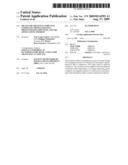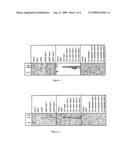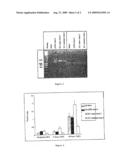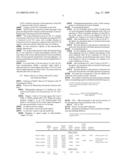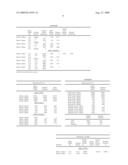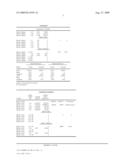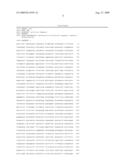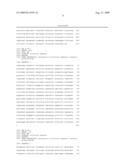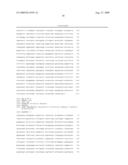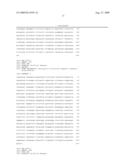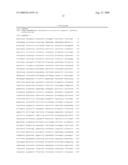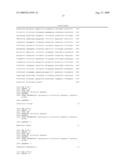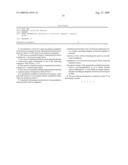Patent application title: Means for Obtaining Avirulent Leishmania Promastigotes, Promastigotes Obtained, and the Applications Thereof
Inventors:
Jean-Loup Lemesre (Montpellier, FR)
Philippe Holzmuller (Poussan, FR)
Rachel Bras-Goncalves (Montpellier, FR)
Assignees:
INSTITUT DE RECHERCHE POUR LE DEVELOPPEMENT (I.R.D.)
IPC8 Class: AA61K39008FI
USPC Class:
4242691
Class name: Antigen, epitope, or other immunospecific immunoeffector (e.g., immunospecific vaccine, immunospecific stimulator of cell-mediated immunity, immunospecific tolerogen, immunospecific immunosuppressor, etc.) parasitic organism or component thereof or substance produced by said parasitic organism (e.g., schistosoma, dirofilaria, trichinella, fasciola, ancylostoma, ascaris, etc.) parasitic protozoan (e.g., trypanosoma, trichomonas, leishmania, entamoeba, etc.)
Publication date: 2009-08-27
Patent application number: 20090214595
Claims:
1. An expression vector for a gene encoding an antigenic leishmania
promastigote protein, characterized in that it comprises an insert of a
PSA gene in an antisense orientation.
2. The vector as claimed in claim 1, characterized in that it contains an L. amazonensis gene insert.
3. The vector as claimed in claim 2, characterized in that the L. amazonensis gene corresponds to one of the following sequences: SEQ ID Nos. 1 to 5.
4. The vector as claimed in claim 1, characterized in that it contains an L. infantum gene insert.
5. The vector as claimed in claim 4, characterized in that the L. infantum gene corresponds to SEQ ID No. 6.
6. A genetically modified leishmania promastigote, characterized in that it is an avirulent mutant, transfected with a vector as claimed in claim 1.
7. A method of obtaining avirulent forms of promastigotes, characterized in that it comprises:nondirectional insertion, into a leishmania expression vector, of genes encoding antigenic leishmania peptides or proteins,selection of the vectors containing the inserts in an antisense orientation,transfection of leishmania promastigote forms using the selected vectors,biological cloning of the genetically modified promastigotes by micromanipulation so as to obtain mutants which underexpress, or even which no longer express, the gene encoding an antigenic leishmania promastigote protein.
8. The use of the promastigotes as claimed in claim 7, for developing vaccines.
Description:
[0001]The invention relates to means for obtaining avirulent leishmania
promastigotes. It also relates to the promastigotes obtained and to the
uses thereof, in particular in immunoprophylaxis.
[0002]Leishmaniases constitute worldwide endemic parasitic infections which represent a considerable public health problem affecting both developing countries and countries such as those of southern Europe, where they are considered to be opportunistic diseases in immuno-depressed individuals.
[0003]At the current time, no effective immunoprophylactic or immunotherapeutic means exist against leishmaniases, and more particularly against the responsible infectious agent, namely leishmania parasites.
[0004]Leishmania parasites are flagellate protozoa belonging to the Trypanosomatidae family and to the Leishmania genus. This family includes parasites which can infect humans, and certain animals such as rodents, canines, or mammals.
[0005]The biological cycle of protozoa of the Leishmania genus is shared between an invertebrate vector host, the sandfly (small hematophagous dipterous insect), and many vertebrates, including humans. The leishmania have a heteroxenous parasitic developmental cycle during which two distinct morphological stages follow on from one another. In the sandfly, the parasite is in a mobile, extracellular, flagellate form inside the digestive tube of the insect, called promastigote stage. In the invertebrate host, the parasite transforms into an immobile ovoid form of from 2 to 6 μm in diameter, with a very short flagellar residue, called amastigote, which will reside in the parasitophorous vacuole, in the cells of the reticulohistiocytic system, mainly macrophages.
[0006]The female hematophagous vector insect becomes infected via the blood of the contaminated vertebrate host, by ingestion of parasitized macrophages. Most of the ingested amastigotes are then destroyed in the following hours. The survivors transform into promastigotes, which will colonize the median intestine, where they actively multiply. They subsequently migrate to the anterior and buccal parts of the digestive tract and then undergo differentiation leading to the formation of metacyclic promastigotes which are highly infectious for the vertebrate host.
[0007]The vertebrate host is contaminated with the metacyclic promastigotes when it is bitten by an infected female sandfly. These promastigote forms are injected into the dermis together with saliva, and will then be phagocytized by the cells of the reticulohystiocytic system, in particular macrophages, inside which they differentiate into immobile intracellular amastigote forms. They will then actively multiply by schizogenesis inside the parasitophorous vacuole (phagolysosome) until lysis of the host cell is brought about, thus allowing the released amastigotes to propagate the infection by colonizing other normal macrophages. A further bite by a sandfly will result in infection of the latter and will allow the parasite to perpetuate its cycle.
[0008]Despite the advances in this field, leishmaniases still remain today a serious public health problem due to the number of individuals involved, the extent of the geographic area covered by the disease, and the diversity and seriousness of the clinical pictures observed.
[0009]The need for effective vaccines against leishmaniases and for novel therapeutic and/or vaccine-related targets for treating these parasitic diseases can therefore be seen.
[0010]During infection, the infectious promastigote forms injected into the mammalian host must evade the host's immune response in order to be able to subsequently invade the macrophages. The parasite must therefore implement mechanisms which allow it to escape this immune response and to be capable of adapting to a new environment. Early recognition of the parasite by the host organism during invasion may thus be a key step in resistance to the infection.
[0011]Surface antigens, lipophosphoglycan (LPG) and gp63 (metalloprotease), also called leishmanolysin, were discovered in the 1980s.
[0012]LPG is the major surface molecule of the promastigote forms, the role of which as a virulence factor has been confirmed.
[0013]gp63 is a major surface protease, also considered to be a virulence factor.
[0014]Antigens of a third type, called PSAs for "Promastigote Surface Antigens", were discovered in 1988-1989. They constitute the major surface antigens of the promastigote forms.
[0015]Excretory/secretory antigens (ESAs), which have been very widely studied in many parasitic microorganisms (nematodes, protozoa, etc.), play an important role in the infection and defense mechanisms of these parasites, since they have the possibility of acting remotely. In leishmania, research studies have for a long time been limited by the difficulty in being able to have ESAs available in sufficient amounts to study them.
[0016]All these antigens appear to play a determining role in the survival and infectiousness of the promastigote forms.
[0017]Prior studies by the inventor in this field had led to the development of completely defined culture media, without macromolecules and free of fetal calf serum, allowing the continuous culture of the promastigote and amastigote forms under axenic and serum-free conditions. These media, described in particular in patent application FR No. 93 05 779, have made it possible to reproduce, in vitro, the complete parasitic developmental cycle of leishmania, such as L. amazonensis and L. infantum, and to have, under natural conditions, a relatively abundant source of ESAs available by simply concentrating the culture medium supernatant metabolized by the parasites. A characterization of leishmania ESAs could thus be carried out.
[0018]Studies performed in the inventors, laboratory have thus shown that the major immunogen of the L. amazonensis ESAs has a molecular mass of 45 kDa. The screening of a promastigote-form cDNA expression library with a monoclonal antibody called E2, produced against this major immunogen, has made it possible to isolate and identify cDNA clones encoding proteins of the PSA family. This antibody is produced by the murine hybridoma IV D6/E2 deposited with the C.N.C.M, 28 rue du Dr Roux, Paris, France, on Nov. 10, 2004, under the No. I-3318, more especially by the murine hybridoma deposited on Feb. 3, 2006, with the CNCM under the No. I-3570. Thus, for the first time, three new PSA cDNA sequences expressed in the promastigote form of L. amazonensis were identified. These isolated cDNAs differ from one another by virtue of the number of LRRs (4, 6 or 7). More recently, a screening of an L. infantum promastigote cosmid library has been carried out using, as radiolabeled probe, the DNA encoding L. amazonensis PSA. A new Leishmania gene, IJ11, has been identified, encoding an excreted/secreted protein of L. infantum, of molecular mass 56 kDa (LiPSA 50s), belonging to the PSA family.
[0019]A functional study of the genes encoding PSAs, major immunogens of the excretory/secretory products of leishmania, was therefore undertaken using the tools provided by genomics. The experimental approach consisted in introducing, into the promastigotes of a leishmania, plasmid constructs capable of inducing a decrease in the level of production of the PSA in order to study the repercussions of these changes on the biology of the parasite and its virulence.
[0020]It thus appeared that the nondirectional cloning, in an expression vector for the IJ11 gene encoding the LiPSA 50s protein, resulted, after selection, in plasmids being obtained which contain the insert in an antisense orientation (Ldi antisense), allowing the under-expression of the PSA in the modified L. infantum promastigotes.
[0021]Advantageously, it was found that these results could be generalized both as regards the leishmania species and as regards the gene inserts encoding antigenic proteins that can be used.
[0022]The aim of the invention is therefore to provide novel expression vector constructs for genes encoding antigenic leishmania promastigote proteins.
[0023]The invention is also directed toward the use of these constructs for obtaining avirulent leishmania promastigote mutants.
[0024]According to yet another aspect, the invention is directed toward the uses of these avirulent mutants for immunoprophylactic purposes.
[0025]The expression vectors according to the invention are characterized in that they contain an insert, in an antisense orientation, of a gene encoding an antigenic leishmania promastigote peptide or protein.
[0026]Advantageously, the cloning into expression vectors of said genes in an antisense orientation allows the peptide or the protein to be underexpressed in the modified leishmania promastigotes.
[0027]Preferably, said vectors are characterized in that they contain a leishmania PSA gene insert.
[0028]In one embodiment of the invention, it is an L. amazonensis gene insert.
[0029]The L. amazonensis PSA genes are more especially chosen from the group comprising SEQ ID Nos. 1 to 5.
[0030]In another preferred embodiment of the invention, it is an L. infantum gene insert.
[0031]The L. infantum genes are advantageously chosen from the group comprising SEQ ID No. 6.
[0032]The invention is also directed toward genetically modified leishmania promastigotes, characterized in that they are avirulent mutants, transfected with a vector as defined above.
[0033]The invention is also directed toward a method of obtaining avirulent forms of leishmania promastigotes, characterized in that it comprises: [0034]nondirectional insertion, into an expression vector, of genes encoding antigenic leishmania peptides or proteins, [0035]selection of the constructs containing the inserts in an antisense orientation, [0036]transfection of leishmania promastigote forms using the selected constructs, [0037]biological cloning of the genetically transformed promastigotes by micromanipulation so as to obtain mutants which underexpress, or even which no longer express, the gene encoding an antigenic leishmania promastigote protein.
[0038]The transfection of the promastigote forms is advantageously carried out by electroporation.
[0039]Revelation of the peptide or of the protein by Western blotting makes it possible to estimate its level of production in the clones.
[0040]The use of the above arrangements makes it possible to study the consequences of the underexpression of antigenic leishmania peptides or proteins on the behavior of the transformed promastigotes and to thus identify their biological role.
[0041]To this effect, the various genetically modified parasites were cloned by micromanipulation (biological cloning) and characterized and compared at the molecular level (level of production of the antigenic protein, level of expression of the corresponding transcripts). The phenotypic characterization of the genetically modified and cloned promastigotes consisted in comparing the growth kinetics of these parasites and also their infectious capacity in vitro with respect to canine macrophages.
[0042]The characterization of a parasitic virulence factor, such as PSA, makes it possible to develop novel strategies for interference with the infectious process for therapeutic and/or vaccine-related purposes.
[0043]In particular, the invention makes it possible to obtain attenuated, or even avirulent, strains that can be used in animal and/or human vaccination.
[0044]Other characteristics and advantages of the invention are given in the examples which follow with reference to FIGS. 1 to 4, which represent, respectively,
[0045]FIGS. 1 and 2, the results of analysis by Western blotting of the PSA of total polypeptide extracts of a wild-type strain of Ldi Mon1 and of excretory/secretory antigens of culture supernatants of wild-type strains, of sense and anti-sense transformed parasitic parent strains and of clones thereof;
[0046]FIG. 3, results of RT-PCR on transcripts of a gene encoding PSA and of a housekeeping gene;
[0047]FIG. 4, the parasitic index determined over the course of the in vitro infection of canine macro-phages with a wild-type strain or clones.
MATERIALS AND METHODS
I--In vitro Cultures
[0048]1--Axenic Cultures of L. infantum
[0049]The wild-type strain of Leishmania infantum used in the studies described hereinafter bears the WHO reference: MHOM/MA/67/ITMAP-263/clone2, zymodeme MON-1. The transformed strains were obtained after cloning of the IJ11 gene (1404 bp), encoding the L. infantum PSA (56 kDa), in the sense or antisense position in the expression vector pTEX, and then transfection by electroporation into the promastigote form of L. infantum. The Ldi IJ11 antisense, Ldi pTEX transformed parasites were selected in the presence of increasing concentrations of geneticin up to 50 μg/ml. The presence of the plasmid and the orientation of the transgene (antisense) were verified by Southern blotting and the level of transcription of the transgene was verified by Northern blotting.
[0050]The promastigote forms are cultured under axenic conditions in a completely defined culture medium containing no macromolecule as serum substitute (serum-free RPMI 199H medium, pH 7), but also in RPMI 1640 medium containing 20% of decomplemented fetal calf serum (20% serum RPMI medium, pH 7.2), and supplemented with penicillin (100 units/ml) and with streptomycin (100 μg/ml). The various transformed strains were cloned by the micromanipulation technique. A single parasite is sampled under a microscope using a fine glass needle and deposited on NNN medium (Novy, macNeal, Nicolle). The culturing of the parasites is carried out by successive subculturings in 20% RPMI medium. The genetically modified promastigote forms and the corresponding clones are maintained in continuous culture by weekly subculturings in serum-containing culture media or adapted in serum-free medium at 25° C. in the presence of geneticin (50 μg/ml). The parasite concentration is determined by flow cytometry (FacsCalibur, Beckton Dickinson). The parasites are conserved by cryofreezing of the organisms in culture in the presence of 3% DMSO (dimethyl sulfoxide) at -180° C. in liquid nitrogen.
[0051]2--Macrophage Cultures
[0052]PBMCs (Peripheral Blood Mononuclear Cells) are isolated from whole blood of a normal dog by Ficoll gradient (Ficoll Lymphoprep®, density 1.077±0.001 g/ml; AbCys, France) and by centrifugation at 700 g for 20 min at ambient temperature. The cells are then washed 3 times in PBS (0.01M phosphate buffered saline, pH 7.2) without Ca2+/Mg2+ by centrifugation at 400 g for 10 min at 4° C., before being resuspended in RPMI 1640 supplemented with 10% of fetal calf serum, 100 units/ml of penicillin and 100 μg/ml of streptomycin, and then cultured at 37° C.
II--Harvesting and Preparation of the Parasite Material
[0053]1--Harvesting of the Parasite Material
[0054]The promastigote forms in the stationary growth phase (7 days) are harvested by centrifugation of the serum-free parasite cultures at 3000 g for 10 min at 4° C. The parasite pellets and the culture supernatants thus dissociated are then treated separately.
[0055]2--Preparation of Parasite Lysates
[0056]The parasite pellet is washed twice in PBS under the centrifugation conditions described above. After the final wash, the number of parasites harvested is determined by flow cytometry. 109 washed parasites are resuspended in a hypotonic lysis solution: 50 mM Tris, pH 8, containing 1% of Triton X100 (Sigma). After incubation at 4° C. for 20 min, centrifugation for 20 min at 4° C. and at 2000 g makes it possible to separate the insoluble material (debris) from the supernatant (soluble molecules). This supernatant corresponds to a total polypeptide extract (TPE).
[0057]3--Concentration of the Excretory/Secretory Antigens (ESAs) from the Culture Supernatant Metabolized by the Parasites
[0058]10 ml of supernatant metabolized by the parasites are filtered through a Millipore membrane (0.22 μm) and then frozen in shells before being freeze-dried. The freeze-dried materials are taken up in 1 ml of milliQ water in order to be dialyzed for 48 h at 4° C. so as to remove the salts. A second freeze-drying process makes it possible to concentrate the supernatant 200-fold.
III--Biochemical Analyses
[0059]1--Protein Assay
[0060]The assaying of the proteins is carried out using the Beckman DU-600 spectrophotometer, at 595 nm, according to the Bradford method, using the Biorad reagent (Biorad Protein Assay Kit 11). A standard range, from 5 to 20 μg/ml, is prepared from a standard bovine albumin solution (1 mg/ml BSA, Sigma).
[0061]2--SDS-PAGE (Sodium Dodecyl Sulfate-Polyacrylamide Gel Electrophoresis) Analysis
[0062]The SDS-PAGE polyacrylamide gel analysis was carried out in a mini-gel electrophoresis tank (Biorad). The acrylamide percentages used are 5% for the stacking gel and 10% for the separating gel, thereby making it possible to separate proteins of 10 to 200 kDa. TPE protein concentrations are mixed (v/v) with sample buffer containing 4% SDS, 20% glycerol and 0.5% bromo-phenol blue in 0.5M Tris-HCl, pH 6.8.
[0063]The electrophoretic migration is carried out in a buffer (2.5 mM Tris/19.2 mM glycine, pH 8.3) containing 0.1% SDS under a constant voltage of 80V. The calibration of the gel is obtained by depositing 10 μg of standard proteins of known molecular weights (Mark12 Wide Range Protein Standard/SeeBlue® Plus2 Pre-Stained Standard, Novex).
[0064]3--Revelation of the Proteins with Silver Nitrate
[0065]After removal of the SDS by washing in the presence of acetic acid (10%) and ethanol (40%) for 1 h, the acetic acid is then itself removed by two rinses for 30 min in 50% ethanol. The gels are then incubated for 15 min in a staining mixture: 19.4% AgNO3-0.36% NaOH. After 5 washes in milliQ water, a revealing solution containing 0.02% formaldehyde in 1% citric acid (w/v) reveals the proteins on the gel. The revelation threshold for this staining method is 2 ng of protein equivalent.
IV--Immunoanalyses
[0066]1--Western Blotting
[0067]After having been separated in an SDS-PAGE polyacrylamide gel, the proteins are blotted onto a nitrocellulose membrane (Amersham, Hybond-C Extra). The blotting is carried out under semi-dry conditions. The membranes are then saturated for one hour in a TBS-5% milk blocking solution. The membranes are incubated overnight at ambient temperature and with agitation, with the F5 monoclonal antibody directed against PSA and obtained in mice (MAB F5), diluted to 1/50 in TBS. After 3 washes for 5 min in TBS, the bound antibodies are detected with peroxidase-coupled anti-mouse immuno-globulin G secondary antibodies (Tebu) diluted to 1/500 in TBS and incubated for 45 min at ambient temperature with agitation. Next, 3 washes for 5 min in TBS are carried out before revealing the reaction with a solution containing 15 mg of 4-chloro-1-naphthol dissolved in 5 ml of methanol, to which are added 25 ml of TBS containing 15 μl of 30% H2O2. The reaction is stopped by washing the membrane with distilled water.
[0068]2--Indirect Immunofluorescence on Parasites
[0069]The parasites in the stationary phase of their culture (7 days) are fixed with 1% formaldehyde in PBS without Ca2+/Mg2+, and then washed. Once fixed, the parasites are deposited on Teflon-coated wells (10 wells, 50 ml/well) and dried in the open air. Each well is then processed with the F5 monoclonal antibody (MAB F5) diluted in a (saturating) blocking solution (1% goat serum, 0.5% BSA in PBS) for 30 min at 37° C. The cells are then washed and incubated for 30 min at 37° C. with the second antibody conjugated to fluorescein isothio-cyanate (FITC) (goat anti-mouse immunoglobulin G anti-serum) diluted to 1/300 in a solution of PBS containing Evans blue at 1/7500. The slides are observed under a photon fluorescence microscope (Leitz).
V--Molecular Analysis
[0070]1--Total RNA Extraction
[0071]The promastigote forms are harvested by centrifugation of the serum-free parasite cultures at 3000 g for 10 min at 4° C. The parasite pellet is washed twice in PBS under the above centrifugation conditions. After the final wash, in order to lyse the parasites and to inhibit the endogenous ribonucleases (RNAses), the cells are dissociated by vortexing in 1 ml of Trizol (Trizol Reagent, GibcoBRL), and then incubated for 5 min at ambient temperature. The lysate is incubated in 0.2 ml of chloroform for 2 min at ambient temperature, and then centrifuged at 12 000 g for 15 min at 4° C. so as to give two phases, an aqueous phase and an organic phase. The RNAs are exclusively in the aqueous phase, which is recovered. The RNAs are then precipitated by adding 0.5 ml of isopropanol and incubated for 10 min at ambient temperature, and then centrifuged at 12 000 g for 10 min at 4° C. The pellet is washed in 1 ml of 75% ethanol, and then centrifuged at 7500 g for 5 min at 4° C., before being taken up in 40 μl of water (RNAse-free). In order to remove any possible presence of DNA, the dissolved RNA pellet is taken up in 1 μl of DNAse I+0.1 volume of 10× DNAse I buffer, and incubated for 20 min at 37° C. After the addition of 5 μl of DNAse inactivation reagent, incubation for 2 min at ambient temperature and then centrifugation at 10 000 g for 1 min at 4° C., the supernatant containing the RNAs is recovered. The total RNA is quantified by spectrophotometry, the absorbance being read at 260 nm (1 OD unit=40 μg/ml of single-stranded RNA). The quality of the extracted RNA and the amount and the size are verified by electrophoresis on 1% agarose gel in 0.5× TAE buffer, in the presence of 0.01% ethidium bromide (ETB). The size marker used is the SmartLadder (Eurogentec). The total RNA is then visualized under UV at 312 nm after migration. The selected criteria for quality of the extraction are the absence of DNA and the visualization of 3 ribosomal RNA bands of equal intensity.
[0072]2--RT-PCR
[0073]The single-stranded cDNA is synthesized by carrying out an RT-PCR with 1 μg of total RNA, 2 μl of dNTP mix (5 mM), 0.2 μl of specific primers (10 μM) and H2O qs 13 μl. The mix is incubated for 2 min at 65° C. and then for 2 min in ice, before the following are added: 4 μl of 5× buffer, 1 μl of DTT (0.1M), 1 μl of Superase In (40U) (RNAse Inhibitor, Ambion) and 1 μl of SuperScript® (200U) (Reverse Transcriptase, Invitrogen). The mix is incubated for 50 min at 42° C., and the reaction is then inactivated by heat shock for 15 min at 70° C.
[0074]The single-stranded cDNA is amplified by PCR with 3 μl of cDNA, 12.5 μl of PCR Mastermix (Promega), 1 μl of 5'P and 3'P specific primers (10 μM) and H2O qs 25 μl. The following primers were used:
TABLE-US-00001 SEQ ID No. 7 -nhinsp1: 5'-CATCGCTTACCCCTTGTT-3' SEQ ID No. 8 -nhinsp2: 5'-GTGGCCAATCGCGACA-3' SEQ ID No. 9 -P1RT: 5'-ATGGCGCTGTGCGTGCGTCGG-3' SEQ ID No. 10 -P4RT: 5'-GCGCGCGACAGCAGCGGCAT3'.
[0075]The program of the PCR reaction used and carried out in a thermocycler (GeneAmp PCR System 2400, Applied Biosystems) is the following: 5 min at 94° C., then 27 cycles (94° C. 30 sec, 55° C. 1 min, 72° C. 1 min) and 10 min at 72° C.
[0076]The PCR products are verified by 1% agarose gel electrophoresis.
VI--Biological Analysis
[0077]1--Growth Kinetics
[0078]The in vitro culture kinetics were realized over 10 days in RPMI 20% medium, starting from an initial concentration of 5×105 parasites/ml. The parasite concentration is determined by flow cytometry (FacsCalibur, Beckton Dickinson), by mixing 500 μl of PBS, 5 μl of culture and 0.5 μl of propidium iodide.
[0079]2--In vitro Infection in Parasite/Macrophage Interactions
[0080]106 PBMCs/well (200 μl), isolated from normal dog whole blood, are distributed in LabTek® culture chambers (Nalge Nunc International). After incubation for 30 min at 37° C., 5% CO2, the LabTek® are washed gently with RPMI 10% in order to remove the cells which have not adhered. The macrophages are obtained from the cultured monocytes after 5 days of maturation. The mature macrophages are infected in vitro with promastigote forms in the stationary culture phase, for 30 min, 2 h and 48 h at 37° C. and 5% CO2 at a parasite:macrophage ratio of 10:1. The macrophages are then washed gently twice in order to remove the nonphagocytozed parasites. After 30 min, 2 h and 48 h, the cells are fixed with methanol and stained with Giemsa. 300 macrophages are observed under an immersion optical microscope (1000× magnification), and the percentage of parasitized macrophages, the number of amastigotes per macrophage and the parasitic index (P.I.) are determined. The P.I. is equivalent to the percentage of infected macrophages multiplied by the number of amastigotes per macrophage.
RESULTS
[0081]Evaluation of the Level of Production of PSA in the Transformed Clones
[0082]FIGS. 1 and 2 report the results of Western blotting analysis of the PSA, respectively, [0083]of total polypeptide extracts (TPE) derived from the parasite pellets of the wild-type strain Ldi Mon1, [0084]on excretory/secretory antigens (ESAs) derived from metabolized culture medium supernatants of the wild-type strain Ldi Mon1, of the parent strains of transformed parasites (Ldi pTEX, Ldi IJ11 sense and Ldi IJ11 antisense) and of their corresponding clones (5 μg protein equivalent of total extract per lane). It is noted that no band is observed for the wild-type strain Ldi Mon1, that the overexpression is, on the other hand, clearly visible for Ldi IJ11 sense, both at the level of the TPEs and the ESAs, compared with the expression in Ldi pTEX, and that a decrease in the expression of the PSA is observed with Ldi IJ11 antisense.
[0085]Analysis of the PSA Transcripts by RT-PCR
[0086]An RT-PCR was carried out on the transcripts of the gene encoding the PSA and also on the transcripts of a housekeeping gene encoding nucleoside hydrolase.
[0087]The results obtained are given in FIG. 3. A significant increase in the level of the transcripts encoding the PSA is observed in Ldi IJ11 sense, and a notable decrease is observed in Ldi IJ11 antisense, compared with Ldi pTEX. No signal is observed with the wild-type strain of Ldi Mon1.
[0088]In vitro Infectious Capacity in the Parasite-Macrophage Interactions
[0089]FIG. 4 reports the parasitic index determined during the in vitro infection of canine macrophages with the wild-type strain or the various selected clones at various incubation times: 30 min (parasite attachment to the macrophages), 2 h (parasite penetration) and 48 h (survival and multiplication of amastigotes).
[0090]It is noted that, at 30 min and at 2 h, the Ldi IJ11 sense promastigotes exhibit a parasitic index which is approximately two times higher than those of Ldi IJ11 antisense is approximately two times lower. The same results are obtained after 48 h of infection.
VII--Study of the In vivo Role of the pTEX, Sense and Antisense Mutant
[0091]Infection of Balb/C Mice by IP Injection with 108 Promastigotes/100 μl
[0092]Protocol for Measuring Parasitemia (Parasite Burdens) [0093]Bibliographic reference: P. A. Buffet et al., 1995. Antimicrobial agents and chemotherapy. Vol. 39: 2167-2168 [0094]Prepare: 1 tube of 15 ml per organ with 4 ml of SDM or RPMI medium/20% FCS Weigh the tubes+medium (weight=T in g) Cell Strainer+small Petri dishes (1 cell strainer for two same organs belonging to the same group/batch of mice)+1 ml syringe
[0095]On spleen and liver organs:
[0096]For the spleen: remove the entire spleen
[0097]For the liver: remove only the small lobe [0098]Weighing of organs (organ in tube+medium, weight=TO in g) [0099]Grinding/homogenization with a Potter homogenizer or cell strainer in 4 ml of medium.
[0100]For parasitemia/spleen: [0101]In a 96-well plate, remove 250 μl of cells for the 1st well and prepare doubling dilutions with 150 μl of parasites in 150 μl of medium, and then, for the following wells, remove 150 μl to be diluted in 150 μl of medium, etc. Prepare 2×12 wells of dilutions (2 rows). [0102]After incubation for 7 and 15 days at 26-28° C., the plates are examined under an inverted microscope (×100 or ×200 objective). [0103]Note the absence or the presence of parasites for each well. Note the last well where parasites are present.
[0104]For parasitemia/liver: [0105]In a 96-well plate, remove 25 μl of cells for the 1st well containing 225 μl of medium and prepare 4-fold serial dilutions with 50 μl of parasites in 150 μl of medium, and then, for the following wells, remove 50 μl to be diluted in 150 μl of medium, etc. Prepare 2×12 wells of dilutions (2 rows). [0106]After incubation for 7 and 15 days at 26-28° C., the plates are examined under an inverted microscope (×100 or ×200 objective). [0107]Note the absence or the presence of parasites for each well. Note the last well where parasites are present.
[0108]The final titer corresponds to the last dilution for which the well contains at least 1 parasite.
[0109]The number of parasites per gram (parasite burden) in the corresponding organ is calculated in the following way:
Number of parasites=(geometric mean of the inverse titers of each duplicate/weight of section homogenized)×400
Parasite burden = inverse of the limiting dilution organ weight ( g ) × 400 ##EQU00001##
[0110]N.B.:--400 corresponds to the inverse fraction of the homogenized organ inoculated in the 1st well [0111]<103 to >106
[0112]Point at 14 days after infection:
[0113]Parasitemia (reading at 15 days) carried out in duplicate and doubling dilutions
Parasite burden=(inverse of the limiting dilution/organ weight (g))×400
TABLE-US-00002 General Organ Parasite Mean mean weight Limiting burden Parasite Standard Parasite Standard (g) dilution Parasite g-1 burden deviation burden deviation g Batch 1 pTEX Mouse 1 spleen 0.14 0.0078 366300 274725 129507 107912 56756 without mouse 1 trial 0.14 0.0156 183150 183150 Mouse 2 spleen 0.16 0.0156 160256 120064 56840 without mouse 1 trial 0.16 0.0313 79872 67348 22927 1 and 2 and Mouse 3 spleen 0.14 0.0625 45714 68498 32222 without mouse 2 trial 0.14 0.0313 91283 Mouse 4 spleen 0.16 0.0625 40000 59936 28194 0.16 0.0313 79872 Batch 2 sense Mouse 1 spleen 0.14 0.5 5714 2857 4041 2367 1517 0.14 nothing 0 Mouse 2 spleen 0.19 nothing 0 2105 2977 0.19 0.5 4211 Mouse 3 spleen 0.24 1 1667 833 1179 0.24 nothing 0 Mouse 4 spleen 0.17 0.25 9412 7059 3328 0.17 0.5 4706 4706 Mouse 5 spleen 0.15 1 2667 1333 1886 0.15 nothing 0 Batch 3 antisense Mouse 1 spleen 0.13 0.25 12308 12308 0 8744 2458 0.13 0.25 12308 Mouse 2 spleen 0.14 1 2857 1429 2020 0.14 nothing 0 Mouse 3 spleen 0.15 0.5 5333 8000 3771 0.15 0.25 10667 Mouse 4 spleen 0.18 0.25 8889 6667 3143 0.18 0.5 4444 Mouse 5 spleen 0.20 0.25 8000 8000 0 0.20 0.25 8000 results in red not taken into account
TABLE-US-00003 Summary point 15 d Mean Parasite Standard Mean burden deviation deviation Batch 1 pTEX Mouse 1 spleen 274725 129507 91575 Mouse 2 spleen 120064 56840 40192 Mouse 3 spleen 68498 32222 22784 Mouse 4 spleen 59936 28194 19936 Batch 2 sense Mouse 1 spleen 2857 4041 2857 Mouse 2 spleen 2105 2977 2105 Mouse 3 spleen 833 1179 833 Mouse 4 spleen 7059 3328 2353 Mouse 5 spleen 1333 1886 1333 Batch 3 antisense Mouse 1 spleen 12308 0 0 Mouse 2 spleen 1429 2020 1429 Mouse 3 spleen 8000 3771 2667 Mouse 4 spleen 6667 3143 2222 Mouse 5 spleen 8000 0 0 Mean Parasite Standard burden deviation pTEX mouse 2 spleen 120064 56840 pTEX mouse 3 spleen 68498 32222 pTEX mouse 4 spleen 59936 28194 Sense mouse 1 spleen 2857 4041 Sense mouse 2 spleen 2105 2977 Sense mouse 3 spleen 833 1179 Sense mouse 4 spleen 7059 3328 Sense mouse 5 spleen 1333 1886 Antisense mouse 1 spleen 12308 0 Antisense mouse 2 spleen 1429 2020 Antisense mouse 3 spleen 8000 3771 Antisense mouse 4 spleen 6667 3143 Antisense mouse 5 spleen 8000 0 Parasite Standard burden deviation pTEX 82833 3252 Sense 2838 248 Antisense 7281 390
TABLE-US-00004 Parasitemia (2 months) Parasite General Organ burden Mean mean Standard weight Limiting parasite Parasite Parasite deviation SPLEEN (g) dilution g-1 burden burden g Batch 1 pTEX Mouse 1 spleen 0.14 0.016 182857 264127 118470 Mouse 2 spleen 0.14 0.008 365714 Mouse 3 spleen 0.17 0.031 75294 Mouse 4 spleen 0.18 0.016 142222 Mouse 5 spleen 0.14 0.008 365714 Batch 2 sense Mouse 1 spleen 0.1 NI 0 0 0 Mouse 2 spleen 0.15 NI 0 Mouse 3 spleen 0.12 NI 0 Mouse 4 spleen 0.14 NI 0 Mouse 5 spleen 0.14 NI 0 Batch 3 antisense Mouse 1 spleen 0.11 NI 0 1813 2914 Mouse 2 spleen 0.12 0.500 6667 Mouse 3 spleen 0.19 0.500 4211 Mouse 4 spleen 0.13 NI 0 Mouse 5 spleen 0.14 NI 0 Mouse 6 spleen 0.18 NI 0 Parasite burden g-1 Standard deviation Spleen 15 days 2 months 15 days 2 months pTEX 107912 264127 56756 118470 Sense 2367 0 1517 0 Antisense 8744 1813 2458 2914 pTEX 67348 264127 22927 118470 Sense 2367 0 1517 0 Antisense 8744 1813 2458 2914 results in red not taken into account NI = non infected
TABLE-US-00005 Parasitemia (2 months) Organ Parasite weight Limiting burden LIVER (g) dilution parasite g-1 Batch 1 pTEX 2495238 4025557 with mouse 1 Mouse 1 liver 0.12 0.000391 8533333 Mouse 2 liver 0.1 0.000024 163840000 482540 43989 without mouse 1 Mouse 3 liver 0.14 0.006250 457143 Mouse 4 liver 0.14 0.006250 457143 Mouse 5 liver 0.12 0.006250 533333 Batch 2 sense Mouse 1 liver 0.17 NI 0 0 0 Mouse 2 liver 0.18 NI 0 Mouse 3 liver 0.12 NI 0 Mouse 4 liver 0.14? NI 0 Mouse 5 liver 0.09 NI 0 Batch 3 antisense Mouse 1 liver 0.12 NI 0 38889 61162 Mouse 2 liver 0.16 0.025 100000 Mouse 3 liver 0.1 NI 0 Mouse 4 liver 0.08 NI 0 Mouse 5 liver 0.12 0.025 133333 Mouse 6 liver 0.1 NI 0
Sequence CWU
1
1012333DNAArtificial SequenceDescription of Artificial Sequence Synthetic
polynucleotide 1gacccctgtt gcgaatggcg cagtgcgtgc gtcggctggt
gctggcggcg cccctcgccg 60ctgtggtggc gctgctgctg tgcacgagca gtgcaccggt
ggcgcgtgct gcggggacga 120gcgacttcac tgaggcgcag cagacgaaca cgctgacggt
gctgcaggcg tttgcgcgtg 180cgatccctgc gcttggggac acgtggacgg gcagcgactt
ctgctcgtgg aagcacatca 240tctgcgactc ccccggcgtc ggcgtgtgga tgggcgatgt
ggattatacc ggcacgctgc 300cggagatgcc tgcgagcgtc gactacaagg acgtcatgat
cacggaactg aacttcagcg 360caatgggcca ggggctgagc gggacgctgc ccccctcatg
gagctcgctg acgtccttga 420tatcactgtg catcgaaaag tctgagaagg tcaccggcac
gctgcctgcc cagtggagct 480cgatgacgtc gctggacaac cttaacctgc acgacacggc
ggtctccggc acgctgcctg 540cccagtggag ctcgatgaag cagctgaccg ttctggatct
ggagggcact aaggtgtccg 600gcacgctgcc gtccgagtgg agtgggatgg cgaaggccga
ggccgtgcag ctggagaact 660gcggtctgtc cgggagtctg cccccctcgt ggtctgcgat
gccgaagctg cgtatcgtct 720cactgagcgg caaccacttc tgcgggtgcg tgcccgactc
gtggagggag aaggaccgcc 780tcgatgtgac catcgaggaa tggcacatgg gcgaggactg
caagcttgct aacgcctgcc 840gcccgactgc tgctccggga acgaccacga ctaacccgcc
caccaccacc ggcaccccag 900cagcctcctc tactccttct ccagggtcgg ggtgcgaggt
ggatgggtgt gaggtgtgcg 960agggggactc cgctgcgcgg tgcgccaggt gccgtgaggg
ctactccctg acggacgaga 1020agacgtgcct ggcgaaccac gatggcggcg tggcggcggc
gtcgagcgga gcggtggctg 1080ccgctgctgt gtgggcggct gtgctgttga gcgtggggct
ggtggcgtga gggtgcggcg 1140ggcccctctt ctctgtggtg cccctggtgc ctgccctcgc
ccccggcacg gcgtcgtcgc 1200tgccctctct cacccccacc agccgacggg gagaccgaca
gccacacgcg cacgcgcaca 1260cgccgtcgtg catcgcgtgt gctttccgcc gttgtggcgc
ctgcacggat gcacgggcat 1320gcggaggcgt gcatgcgtgt gcgcgtgcca gctcttgtgt
gtctctccgt gtggccagca 1380gtcggcaccc gcgccgatcg aatgtgcgcg cggcggcggt
gtgtcgcctt ggacagcgga 1440tgcgggcgcc cgcccctcgc cgtgtgccct gcggtctgct
gtgctgccgc gcgagcgacg 1500tacggatgcg ctgtccggcc ctcttcgacg gggctcgctt
gcggtgctgt gctctcgtgg 1560tctgtgccgg tgctgccctg gcggggtgag agctggcggg
ggcgtgggtg cgcgcgcggc 1620agctctccgc tgcgttgagg gcggcctgcc cctgcgtccg
cgcaccgtcg cgctctcctc 1680gacgccactg cgcgcgcttg ttggcttgct ttgctctgtc
gtgcgcactc tctcttattt 1740tccgtttcat tcgcctgtat tctcttctcc caccgcactg
cggcctcgtc accgcggccg 1800tgcggtgcgc aggcgggtga tgtgccgttg tgccccccct
ttcatggcgc gctgggccga 1860tcgccctctt gcctccctcc tccccctccc cctcccgccg
gtcctgtcaa ttgtatatcc 1920gtggacctta tcttcgtact gcctccgcgc ctcttccgta
aagcttcgtt ggcgtgtgcc 1980gccccccgga cgtcagcgcc gctgtgctcg catgctcacg
gtgcgtcccc gtgcgtgggc 2040gtgcacgtaa ggacatgtat atatgtatgt gtatgtatat
gagtatgtat atatgtacgg 2100ttatatatag gaatttgtgt atgttgaggt gtatgcatgt
gcgtgcgtat attagtgtgt 2160gcgagcacgc gtgttgcgcc acgctctgct gcccgcctcc
gctgtgcgtg tcactcgctg 2220tgggcgcggt ggcgggtggc gccgggtggt ggccgtgcgg
cgggcggggg ctcctctgtg 2280tttctctatt tctctgttcc ctgttgacct caaaaaaaaa
aaaaaaaaaa aaa 233321081DNAArtificial SequenceDescription of
Artificial Sequence Synthetic polynucleotide 2cgtggacggg cagcgacttc
tgctcgtgga agcacatcat ctgcgactcc cccggcgtcg 60gcgtgtggat gggcgatgtg
gattataccg gcacgctgcc ggagatgcct gcgagcgtcg 120actacaagga cgtcatgatc
acggaactga acttcagcgc aatgggccag gggctgagcg 180ggacgctgcc cccctcatgg
agctcgctga cgtccttgat atcactgtgc atcgaaaagt 240ctgagaaggt caccggcacg
ctgcctgccc agtggagctc gatgacgtcg ctggacaacc 300ttaacctgca cgacacggcg
gtctccggca cgctgcctgc ccagtggagc tcgatgaagc 360agctgaccgt tctggatctg
gagggcacta aggtgtccgg cacgctgccg tccgagtgga 420gtgggatggc gaaggccgag
gccgtgcagc tggagaactg cggtctgtcc gggagtctgc 480ccccctcgtg gtctgcgatg
ccgaagctgc gtatcgtctc actgagcggc aaccacttct 540gcgggtgcgt gcccgactcg
tggagggaga aggaccgcct cgatgtgacc atcgaggaat 600ggcacatggg cgaggactgc
aagcttgcta acgcctgccg cccgactgct gctccgggaa 660cgaccacgac taacccgccc
accaccaccg gcaccccagc agcctcctct actccttctc 720cagggtcggg gtgcgaggtg
gatgggtgtg aggtgtgcga gggggactcc gctgcgcggt 780gcgccaggtg ccgtgagggc
tactccctga cggacgagaa gacgtgcgtg gcgaaccacg 840atggcggcgt ggcggcggcg
tcgagcggag cggtggctgc cgctgctgtg tgggcggctg 900tgctgttgag cgtggggctg
gtggcgtgag ggtgcggcgg gcccctcttc tctgtggtgc 960ccctggtgcc tgccctcgcc
cccggcacgg cgtcgtcgct gccctctctc acccccacca 1020gccgacgggg agaccgacag
ccacacgcgc acgcgcacac gccgtcgtgc atcgcgtgtg 1080c
108131371DNAArtificial
SequenceDescription of Artificial Sequence Synthetic polynucleotide
3ggacgggcag cgacttctgc tcgtggaagc acatcatctg cgactccccc ggcgtcggcg
60tgtggatggg cgatgtggat tataccggca cgctgccgga gatgcctgcg agcgtcgact
120acaaggacgt catgatcatg gcactggact tcggcgcaat gggccaggga ctgagcggga
180cgctgccccc ctcatggagc tcgctgacgt ccttgatgtc actgtggatc gaaaagtctg
240agaaggtcac cggcacgctg cctacccagt ggagctcgat gaagcagctg acccttctgc
300atctgaaggg cactaaggtg tccggcacgc tgccgcccga gtggagtggg atgacgtcgc
360tggacgacct taacctgcac gacacggcgg tctccggcac gctgcctgcc cagtggagct
420cgatgaagca gctgatcgat ctggatctgg agggcactaa ggtgtccggc acgctgccgc
480ccgagtggag tgggatggcg aaggccgagg ccctgcagct gaagtactgc gatctgtccg
540ggagtctgcc cccctcgtgg tcttcgatgc agaagctgcg tatcgtctca ctgagcggca
600accacttctg cgggtgcgtg cccgactcgt ggagggagaa ggaccgcctc gatgtgacca
660tcgaggaatg gcacatgggc gaggactgca agcttgctaa cgcctgccgc ccgactgctg
720ctccgggaac gaccacgact aacccgccca ccaccaccgg caccccagca gcctcctcta
780ctccttctcc agggtcgggg tgcgaggtgg atgggtgtga ggtgtgcgag ggggactccg
840ctgcgcggtg cgccaggtgc cgtgagggct actccctgac ggacgagaag acgtgcctgg
900cgaaccacga tggcggcgtg gcggcggcgt cgagcggagc ggtggctgcg gctgctgtgt
960gggcggctgt gctgttgagc gtggggctgg tggcgtgagg gtgcggcggc cccctcttct
1020ctgtggtgcc cctggtgcct gccctcgccc ccagcacggc gtcgtcgctg ccctctcacc
1080cccaccagcc gaaggggaga ccgacagcca cacgcacacg cgcacgcgcc gtcgtgcatc
1140gcgtgtgctt tccgccgttg tggcgcctgc gcggatgcac gggcatgcgg aggcgtgcat
1200gcgtgtgcgc gtgccagctc ttgtgtgtct ctccgtgtgg ccagcagtcg gcacccgcgc
1260cgatcgaatg tgcgcgcggc ggcggtgtgt cgccttggac agcggatgcg gcgcccgccc
1320ctcgccgtgt gccctgcggt ctgctgtgct gccgcgcgag cgacgtacgg a
137141203DNAArtificial SequenceDescription of Artificial Sequence
Synthetic polynucleotide 4tcggcgtgtg gatgggcgat gtggattata
ccggcacgct gccggagatg cctgcgagcg 60tcgactacaa ggacgtcatg atcacggaac
tgaacttcgg cgcaatgggc cagggactga 120gcgggacgct gcccccctca tggagctcga
tgaagcagct gatcgatctg gatctggagg 180gcactaaggt gtccggcacg ctgccgcccg
agtggagtgg gatggcgaag gccgaggccc 240tgcagctgaa gtactgcgat ctgtccggga
gtctgccccc ctcgtggtct tcgatgcaga 300agctgcgtat cgtctcactg agcggcaacc
acttctgcgg gtgcgtgccc gactcgtgga 360gggagaagga ccgcctcgat gtgaccatcg
aggaatggca catgggcgag gactgcaagc 420ttgctaacgc ctgccgcccg actgctgctc
cgggaacgac cacgactaac ccgcccacca 480ccaccggcac cccagcagcc tcctctactc
cttctccagg gtcggggtgc gaggtggatg 540ggtgtgaggt gtgcgagggg gactccgctg
cgcggtgcgc caggtgccgt gagggctact 600ccctgacgga cgagaagacg tgcctggcga
accacgatgg cggcgtggcg gcggcgtcaa 660gcggagcggt ggctgcggct gctgtgtggg
cggctgtgct gttgagcgtg gggctggtgg 720cgtgagggtg cggcgggccc ctcttctctg
tggtgcccct ggtgcctgcc ctcgcccccg 780gcacggcgtc gtcgctgccc tctctcaccc
ccaccagccg acggggagac cgacagccac 840acgcgcacgc gcacacgccg tcgtgcatcg
cgtgtgcttt ccgccgttgt ggcgcctgca 900cggatgcacg ggcatgcgga ggcgtgcatg
cgtgtgcgcg tgccagctct tgtgtgtctc 960tccgtgtggc cagcagtcgg cacccgcgcc
gatcgaatgt gcgcgcggcg gcggtgtgtc 1020gccttggaca gcggatgctg gcgcccgccc
ctcgcgtgtg cctcggtctg cgtgtcgtgg 1080ccgcgcgagc gacgtacgga gtgcgctgtc
gccgggtggt ggccgtgcgg cgggcggggg 1140ctcctctgtg tttctctatt tctctgttcc
ctgttgacct caaaaaaaaa aaaaaaaaaa 1200aaa
120351207DNAArtificial
SequenceDescription of Artificial Sequence Synthetic polynucleotide
5ccggcgtcgg cgtgtggatg ggcgatgtgg attataccgg cacgctgccg gagatgcctg
60cgagcgtcga ctacaaggac gtcatgatca cggaactgaa cttcagcgca atgggccagg
120ggctgagcgg gacgctgccc ccctcatgga gctcgctgac gtccttgata tcactgtgca
180tcgaaaagtc tgagaaggtc accggcacgc tgcctgccca gtggagctcg atgacgtcgc
240tggacaacct taacctgcac gacacggcgg tctccggcac gctgccgccc gagtggagtg
300ggatgacgtc gctggacgac cttaacctgc acgacacggc ggtctccggc acgctgcctg
360cccagtggag ctcgatgaag cagctgatcg atctggatct ggagggcact aaggtgtccg
420gcacgctgcc gcccgagtgg agtgggatgg cgaaggccga ggccctgcag ctgaagtact
480gcgatctgtc cgggagtctg cccccctcgt ggtcttcgat gcagaagctg cgtatcgtct
540cactgagcgg caaccacttc tgcgggtgcg tgcccgactc gtggagggag aaggaccgcc
600tcgatgtgac catcgaggaa tggcacatgg gcgaggactg caagcttgct aacgcctgcc
660gcccgactgc tgctccggga acgaccacga ctaacccgcc caccaccacc ggcaccccag
720cagcctcctc tactccttct ccagggtcgg ggtgcgaggt ggatgggtgt gaggtgtgcg
780agggggactc cgctgcgcgg tgcgccaggt gccgtgaggg ctactcctga cggacgagaa
840gacgtgcctg gcgaaccacg atggcggcgt ggcggcggcg tcaagcggag cggtggctgc
900ggctgctgtg tgggcggctg tgctgttgag cgtggggctg gtggcgtgag ggtgccgccg
960ccccctcttc tctgtggtgc ccctggtgcc tgccctcgcc cccagcacgg ggtcgtcgct
1020gccctctcac ccccaccagc cgaaggggag accgacagcc acacgcacac gcgcacgcgc
1080cgtcgtgcat cgcgtgtgct ttccgccgtt gtggcgcctg cgcggatgca cgggcatgcg
1140gaggcgtgca tgcgtgtgcg cgtgccaact cttgtgtgtc tctccgtgtg gccagcagtc
1200ggcaccc
120763088DNAArtificial SequenceDescription of Artificial Sequence
Synthetic polynucleotide 6gcgctgctgc cgctggcgct gttgtgtgtg
tgctggggcc gcgccacgca cacgcacggt 60agtgaggggg agccgcagcg accgaccggg
cggagcgggc gggcggaggg gggcgctccc 120gcccgctggt catgctctct gtttcgctgg
ccggcctctc tacgccgctg gcgtgggcgg 180agctccgcgc tgcgtatcgc tcgcccctcg
ctgcccctcc ctgcccctcc tcatgtgcac 240tgctccctcc ctctccctcc ctctacactc
ctcgctgtcc cctcggccga cctccacgga 300cacgcagacg tgcgtgcgca tacacaccac
ccctcacctc gctgctgctg ctgtgacagc 360tctacggacc ctgcccagtc gctgcgcccc
cgccacccgc ctctgtcccc cgcacgaggg 420tacctacgac gtgccggcca ccccgctctg
cccgataagc tgagctggcg ctcacgcccg 480agcaatcccc tcacggatct gctgccgcgc
cgcactgctc ttgaccctgg ctgcgaatgg 540cgctgtgcgt gcgtcggctg gtgctggcgg
cgaccctcgc cgctgtggtg gcgctgctgc 600tgtgcacgag cagtgcgccg gtggcgcgtg
ctgctgtgaa ggatgacttc actgctgcgc 660agcggacgaa cacgctggcg gtgctggagg
cgtttgggcg tgcgatccct gagcttggga 720agctgtggaa gggcgacgac ttctgctttt
gggagtcggt cgtgtgcgat gtgaccgaag 780tgtacttgtg ggaaatcggt gcgacgtata
ccggcacgct gccggagatg cctgtggacg 840tcgactacac ggccgtcatg gtcaagcacc
tcgacttttc ccaaatgggg ctggggctga 900gcggaacgct gccggacagc tggagcaggc
tgcagggact gacctcactt acgttgtcgg 960gctgcggcgt gagcggtacg ctgcccccct
cgtggcgctc gatgaagtct ttggtgtcgt 1020tgtggattga gagttgtgaa agtgttaccg
gcaagctgcc gcctgagtgg agctcgatga 1080aatcgctgag agatctccat ctgcatggcg
cgaaggtttc cggcacgctg ccgcctgagt 1140ggagcacgat gaaatcgctg acccttctcg
atctgcagga cactcaggtt accggcagtc 1200tgccgcctga gtggagctca atgaaatcca
tgaccattct cagtctgaat ggcgcgaagg 1260tttccggcac gctgccaccc cagtggagct
cgatgacatc gctgagcctt ctcagtctgg 1320agggtactca gctctccggc acgctaccgc
cccagtggag tgggatgaca tcgctggtca 1380cgctttttct gcagggtact caggtctccg
gcactctgcc gccgcagtgg agatcgatgt 1440tgaatgccga gttcctgcag ctggagaact
gcgacctgtc cggctgtttg ccccccgagt 1500gggctgcgat gccgaagctg cgtcatgtcg
aacttaaggg caaccagttc gccgggtgtg 1560tgccggactc gtgggctcag aaggccggtc
tcgttgtgga aatcgaggat aagcacacgg 1620gcaacagctg cattgctggt gcggactgcg
caacgacgac cacgaccacc actgaaccca 1680cgtccactgc gagcccaaca gccacgccta
cctctgcccc cgagacggag tgcgaggtgg 1740atgggtgtga ggtgtgcgat ggggactccg
cggcgaggtg cgccaggtgc cgtgagggct 1800acttcctgac ggacgagagg acgtgcctgg
tgtaccgcga tggcggcgtt gtggccgtgt 1860cgatcggagc ggctgctgcc gctgttgtgt
gcatggctgt gctgctgagc gtggggctgg 1920cggcgtgagg atgccgctgc tgtcgcgcgc
aggcggcggc acccgctgcg tggcacacga 1980ctgcgtgctt gcgtgcagca ccgcgccctg
cattggcgtg cgtgtgcgcg tctgtgtgtg 2040catggctgct gacggtgcct ttcgtcctgc
ctctcgctgc ctctgcctct ctccgcgtgt 2100gaatgctgtg ggctgtgttt ggggctctcg
tgcggcgctg ctgtacggct gctgcttctt 2160ctccaccctc ctctctcgca tgccggcgag
ggaggggtgg cacgtgcgcg tgtgccgctg 2220cgcttgcgag tgcgtctgtg tgtgggcctt
caccacgtgc tacggtcacg ccttctcggc 2280tggccactcg cggcgctgag ggcggtgtgc
ccttcccctc gagcgccgtc gcactctctt 2340ccgcgcgcct gcgcgggctt cttcgtgcgc
tgtgctcagc cgtgcgctct cacctctttc 2400ccttttcatt cgcttgtctt ctctcttctc
cccccgcact gcggtctccc ctcctctgcc 2460gtgcggtgcg caggcgggtg acttgccgtt
gcgtctcccc ctttcgtgga gcgctgagcc 2520gatccccctt cggcctccct cctccctcct
cccgtgggtc ctgtctgttg tacatcgtcg 2580gaccgtctct tcgtgttgcc tctccgcacc
ttccgcaaat ctgcgctcgc ctgtgccgcc 2640tctcggactt tatccttact gtgattgtat
tctcacggtg cgtctccgtg tgtgtgtgtg 2700ccacgcaccg cttcttccat gtgtgtcctt
gcttgctctc gtctgccccc ccccctctgc 2760ctcacacatt ccgtgcgtgt gtgcatcacc
gttgggcggc gacatcggtg cccgtccctg 2820ccaccctcta ctccctcatt ctcttgccac
ttcgtgggcg gtgcgtgcat gcatggatgt 2880atatacacgc atagaggggt ggggacgcgg
gggatcctct agagtcgacc tgcaggcatg 2940caagcttggc gtaatcatgg tcatagctgt
ttcctgtgtg aaattgttat ccgctcacaa 3000ttccacacaa catacgagcc ggaagcataa
agtgtaaagc ctggggtgcc taatgagtga 3060gctaactcac attaattgcg ttgcgctc
3088718DNAArtificial SequenceDescription
of Artificial Sequence Synthetic primer 7catcgcttac cccttgtt
18816DNAArtificial
SequenceDescription of Artificial Sequence Synthetic primer
8gtggccaatc gcgaca
16921DNAArtificial SequenceDescription of Artificial Sequence Synthetic
primer 9atggcgctgt gcgtgcgtcg g
211020DNAArtificial SequenceDescription of Artificial Sequence
Synthetic primer 10gcgcgcgaca gcagcggcat
20
User Contributions:
Comment about this patent or add new information about this topic:
| People who visited this patent also read: | |
| Patent application number | Title |
|---|---|
| 20100066128 | CHASSIS FRAME ESPECIALLY FOR A HEAVY VEHICLE |
| 20100066127 | HOOD STRUCTURE FOR VEHICLE |
| 20100066125 | VEHICLE FLOOR STRUCTURE |
| 20100066124 | VEHICLE BODY STRUCTURE |
| 20100066120 | Powered back door for vehicle |

